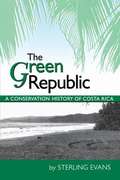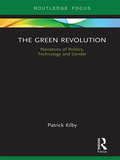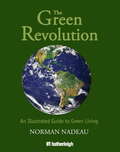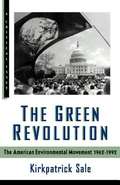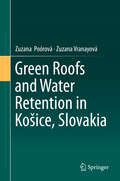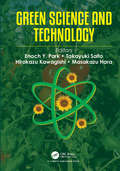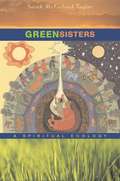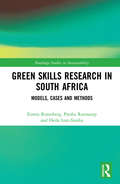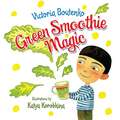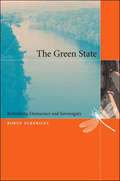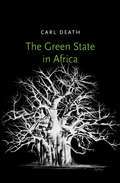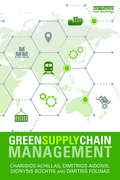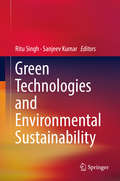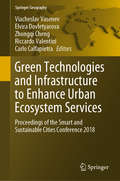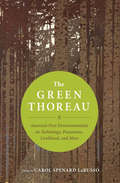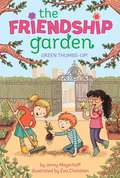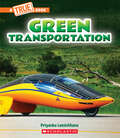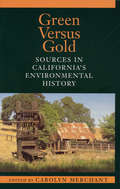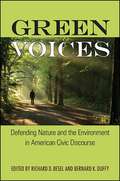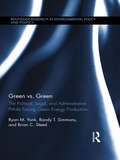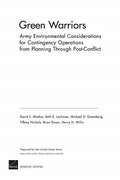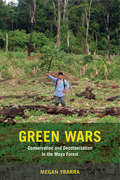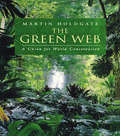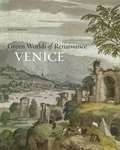- Table View
- List View
The Green Republic: A Conservation History of Costa Rica
by Sterling EvansWith over 25 percent of its land set aside in national parks and other protected areas, Costa Rica is renowned worldwide as "the green republic. " In this very readable history of conservation in Costa Rica, Sterling Evans explores the establishment of the country's national park system as a response to the rapid destruction of its tropical ecosystems due to the expansion of export-related agriculture. Drawing on interviews with key players in the conservation movement, as well as archival research, Evans traces the emergence of a conservation ethic among Costa Ricans and the tangible forms it has taken. In Part I, he describes the development of the national park system and "the grand contradiction" that conservation occurred simultaneously with massive deforestation in unprotected areas. In Part II, he examines other aspects of Costa Rica's conservation experience, including the important roles played by environmental education and nongovernmental organizations, campesino and indigenous movements, ecotourism, and the work of the National Biodiversity Institute.
The Green Revolution: Narratives of Politics, Technology and Gender (Earthscan Food and Agriculture)
by Patrick KilbyThis book reviews the Green Revolution, starting with its inception and development from the 1940s to the 1970s, and leading to what is commonly referred to as a second Green Revolution in the 2000s. Building on the historical assessment, it draws insights for contemporary policy debates and demonstrates important lessons for the here and now. ‘Green Revolution’ refers to the technical measures employed to increase food (particularly grain) production, based mainly on improved seed varieties for higher yields and pest resistance. For it to be successful the Green Revolution often required land reform, investments in irrigation and fertilizer supply that were not available to women and marginal farmers. This book analyses three underlying principles that have guided green revolutions: the political environment in which they were set; how they contributed to both the successes and challenges the Green Revolution continues to face; and the systemic institutional barriers for access to these agricultural production advances, with a focus on how gender relations limit the inclusion of women even when they are the principle cultivators and farm managers. The book draws on experiences in Mexico, India and China, examining government policy, the role of the family farm, and key issues around the inclusion of women. In doing so, this book connects the history of the Green Revolution with contemporary policy debates on the developing world, particularly in relation to Africa and Asia, around foreign aid and agricultural research. It also specifically establishes that greater inclusivity for women and other marginalised farming communities will significantly enhance the effectiveness of these programs. Interlinking themes of development policy, gender, and agricultural research, this book will be of great interest to students and scholars of agricultural development, food security, and sustainable development, as well as policymakers and practitioners working in international aid and agri-food policies.
The Green Revolution
by Norman NadeauEver Wonder What A Green Renewable Sustainable World Would Look Like?With the state of our world and its limited resources, more and more people are trying to lead a greener lifestyle in order to do their part. The Green Revolution provides comprehensive information associated with adopting daily practices that will ultimately sustain, not deplete, precious natural materials in an ever-growing population.Renewable energy expert Norman Nadeau leads by example as he details how he has committed his life to living green. From the application of solar and wind turbine technology, to recovering energy embedded in places one may not expect (such as animals' manure), The Green Revolution highlights the highly sustainable system Norman Nadeau developed for his family farm.The Green Revolution serves as a broad introduction for those who want to conserve rather than squander. At this very important turning point in our planet's history, this book offers the principles by which anyone can live in the most sustainable way possible.
The Green Revolution: The American Environmental Movement (1962-1992)
by Kirkpatrick Sale Eric FonerThe Hill and Wang Critical Issues Series: concise, affordable works on pivotal topics in American history, society, and politics. The Green Revolution documents the tremendous change in public awareness and attitudes since the publication of Rachel Carson'sSilent Spring. Sale assesses the growth of national environmental organizations and the influence of scientists and their theories about global warming, the greenhouse effect, acid rain, toxic waste, and biodiversity. And he shows how environmental concerns affect all levels of society and much of our government's legislative and regulatory work.
Green Roofs and Water Retention in Košice, Slovakia
by Zuzana Poórová Zuzana VranayováThis book discusses how climate change and heat islands are a main contributor to water related problems in urban areas in Košice, Slovakia. Green roofs are used as a tool to assist in solving these water related issues. The need to provide housing in urban areas is expected to rise to 66% in 2050, according to the United Nations. Many urban areas have seen natural permeable green areas replaced with concrete constructions and hard, non-permeable surfaces. The densification of existing built-up areas is responsible for the decreasing vegetation, which results in the lack of evapotranspiration cooling the air, thereby creating urban heat islands. Several studies, discussed in this book, have shown that natural and permeable surfaces, as in the case of green roofs, can play a crucial role in mitigating this negative climate phenomenon and providing higher efficiency for buildings, leading to savings such as water, one of the focal points of this research.
Green Science and Technology
by Enoch Y. Park Takayuki Saito Hirokazu Kawagishi Masakazu HaraThis book provides a comprehensive and up-to-date review of recent trends of green science and technology. Worldwide deterioration of environment and global warming threaten our lifestyle and the survival of all creatures. In order to weather these problems, we need to construct a multidisciplinary approach involving the fusion of various advanced researches. The book begins with an overview on fundamental research about generation and utilization of renewable energy, protection of the earth's ecosystem for better coexistence with nature, development of artificial intelligence-based agriculture and molecular recognitionbased welfare and covers a wide range of innovative research on green science and technology.
Green Sisters: A Spiritual Ecology
by Sarah Mcfarland TaylorGreen Sisters gives us a firsthand understanding of the practice and experience of women whose lives bring together Catholicism and ecology, orthodoxy and activism, traditional theology and a passionate mission to save the planet. As green sisters explore ways of living a meaningful religious life in the face of increased cultural diversity and ecological crisis, their story offers hope for the future--and for a deeper understanding of the connections between women, religion, ecology, and culture.
Green Skills Research in South Africa: Models, Cases and Methods (Routledge Studies in Sustainability)
by Eureta Rosenberg Presha Ramsarup Heila Lotz-SisitkaThis book proposes transformative, realist methodology for skills research and planning through an analysis of case studies of the changing world of work, new learning pathways and educational system challenges. Studies of the green economy and sustainability transitions are a growing field internationally, however there are few books that link this interest to the development of skills. This book draws on, and showcases, the experience and insights of researcher-practitioners who are at the cutting edge in this emerging field, internationally and in South Africa. The context for this book is South Africa, but application is worldwide. In many ways indicative of the global picture, South Africa is in the grip of economic and environmental imperatives, searching for safe and just transitions. The authors present a new, embedded transitioning systems model for studying skills for a sustainable, just future. This book will be of great interest to students and scholars of sustainable development, ecological economics and skills planning.
Green Smoothie Magic
by Victoria BoutenkoVictoria Boutenko responds to the crisis of childhood obesity with a story that makes children excited about nutrition, healthy foods, vegetables and fruits, green smoothies, and the science of plants. This kids' book follows young Nic as he discovers the importance of healthy eating with a plant-rich diet and learns to invent his own healthy recipes for kids. With a pilot father and an artist mother, Nic is an inquisitive child with a fondness for magic. One day, he asks his father where trees come from and is amazed to learn they come from small acorn seeds that grow powered by the sun. His father tells him about the magical green juice, chlorophyll, in all plants. Since humans can't grow with sunlight alone and we don't make our own magical green juice, we need to eat plants to grow big and strong like the oak trees Nic is so fascinated by. Eager to grow big and strong, Nic goes home that night determined to eat more vegetables. He's quickly disheartened when he is put off by the bitter taste of lettuce. But his mother thinks of a way to ensure he can have a tasty, healthy diet. Buying a blender the next day, she whips up some raw-food green smoothie magic. Nic is hesitant at first, but his natural curiosity wins out, and he is soon asking for seconds. The story ends with Nic's own smoothie recipe. Combining sweet fruits with green vegetables, this kids' food recipe promises to be a favorite with children and picky eaters everywhere.
The Green State: Rethinking Democracy and Sovereignty
by Robyn EckersleyWhat would constitute a definitively "green" state? In this important new book, Robyn Eckersley explores what it might take to create a green democratic state as an alternative to the classical liberal democratic state, the indiscriminate growth-dependent welfare state, and the neoliberal market-focused state—seeking, she writes, "to navigate between undisciplined political imagination and pessimistic resignation to the status quo." In recent years, most environmental scholars and environmentalists have characterized the sovereign state as ineffectual and have criticized nations for perpetuating ecological destruction. Going consciously against the grain of much current thinking, this book argues that the state is still the preeminent political institution for addressing environmental problems. States remain the gatekeepers of the global order, and greening the state is a necessary step, Eckersley argues, toward greening domestic and international policy and law.The Green State seeks to connect the moral and practical concerns of the environmental movement with contemporary theories about the state, democracy, and justice. Eckersley's proposed "critical political ecology" expands the boundaries of the moral community to include the natural environment in which the human community is embedded. This is the first book to make the vision of a "good" green state explicit, to explore the obstacles to its achievement, and to suggest practical constitutional and multilateral arrangements that could help transform the liberal democratic state into a postliberal green democratic state. Rethinking the state in light of the principles of ecological democracy ultimately casts it in a new role: that of an ecological steward and facilitator of transboundary democracy rather than a selfish actor jealously protecting its territory.
The Green State in Africa
by Carl DeathA provocative reassessment of the relationship between states and environmental politics in Africa From climate-related risks such as crop failure and famine to longer-term concerns about sustainable urbanization, environmental justice, and biodiversity conservation, African states face a range of environmental issues. As Carl Death demonstrates, the ways in which they are addressing them have important political ramifications, and challenge current understandings of green politics. Death draws on almost a decade of research to reveal how central African environmental politics are to the transformation of African states.
Green Supply Chain Management
by Dimitris Folinas Dimitrios Aidonis Dionysis D. Bochtis Charisios AchillasToday, one of the top priorities of an organization’s modern corporate strategy is to portray itself as socially responsible and environmentally sustainable. As a focal point of sustainability initiatives, green supply chain management has emerged as a key strategy that can provide competitive advantages with significant parallel gains for company profitability. In designing a green supply chain, the intent is the adoption of comprehensive and cross-business sustainability principles, from the product conception stage to the end-of-life stage. In this context, green initiatives relate to tangible and intangible corporate benefits. Sustainability reports from numerous companies reveal that greening their supply chains has helped reduce operating cost, thus boosting effectiveness and efficiency while increasing sustainability of the business. Green Supply Chain Management provides a strategic overview of sustainable supply chain management, shedding light on the theoretical background and key principles of the topic. Specifically, this book covers various thematic areas including benefits and impact of green supply chain management; enablers and barriers on supply chain operations; inbound and outbound logistics considerations; and production, packaging and reverse logistics under the notion of "greening". The ultimate aim of this textbook is to highlight the challenges in the implementation of green supply chain management in modern companies and to provide a roadmap for decision-making in real-life cases. Combining chapter summaries and discussion questions, this book provides an accessible and student-friendly introduction to green supply change management and will be of great interest to students, scholars and practitioners in the fields of sustainable business and supply chain management.
Green Technologies and Environmental Sustainability
by Sanjeev Kumar Ritu SinghIn the present scenario, green technologies are playing significant role in changing the course of nation's economic growth towards sustainability and providing an alternative socio-economic model that will enable present and future generations to live in a clean and healthy environment, in harmony with nature. Green technology, which is also known as clean technology, refers to the development and extension of processes, practices, and applications that improve or replace the existing technologies facilitating society to meet their own needs while substantially decreasing the impact of human on the planet, and reducing environmental risks and ecological scarcities. The concepts of Green Technologies, if endorsed and pervaded into the lives of all societies, will facilitate the aim of the Millennium Development Goals of keeping the environment intact and improve it for the civilization to survive. Green Technologies and Environmental Sustainability is focused on the goals of green technologies which are becoming increasingly important for ensuring sustainability. This book provides different perspectives of green technology in sectors like energy, agriculture, waste management and economics and contains recent advancements made towards sustainable development in the field of bioenergy, nanotechnology, green chemistry, bioremediation, degraded land reclamation. This book is written for a large and broad readership, including researchers, scientists, academicians and readers from diverse backgrounds across various fields such as nanotechnology, chemistry, agriculture, environmental science, water engineering, waste management and energy. It could also serve as a reference book for graduates and post-graduate students, faculties, environmentalist and industrial personnel who are working in the area of green technologies.
Green Technologies and Infrastructure to Enhance Urban Ecosystem Services: Proceedings of the Smart and Sustainable Cities Conference 2018 (Springer Geography)
by Viacheslav Vasenev Elvira Dovletyarova Zhongqi Cheng Riccardo Valentini Carlo CalfapietraThese proceedings of the Smart and Sustainable Cities Conference (SSC) in Moscow from May 23 to 26, 2018 addresses important questions regarding the global trend of urbanization. What are the environmental consequences of megacities’ expansion? What smart solutions can make life in cities safe, comfortable and environmentally friendly? It is projected that 70% of the global population will live in cities by 2050, and as such the book describes how this rapid urbanization will alter the face of the world. Focusing on solutions for the environmental problems of modern megapolises, it discusses advanced approaches and smart technologies to monitor, model and assess the environmental consequences and risks. The contributors present examples of successful sustainable urban development, including management and design of green infrastructure, waste management, run-off purification and remediation of urban soils. The SSC conference and its proceedings offer a valuable contribution to sustainable urban development, and are of interest to the scientific and research community, municipal services, environmental protection agencies, landscape architects, civil engineers, policy makers and other stakeholders in urban management and greenery.
Green This! Volume 1
by Deirdre ImusChange the way you clean and keep your family's home wholesome and healthy with the help of expert and activist Deirdre Imus. We all grew up thinking chemical smells like bleach and ammonia signaled "clean." But as Deirdre Imus reveals, some of the chemicals we use to maintain our homes are doing us and our families much more harm than good. In Greening Your Cleaning, the first in her Green This! series, Deirdre shows how cleaning house the environmentally responsible way can be as effective and often cheaper than the more traditional, toxic, means. This volume includes: Simple, efficient cleaning methods for every room of the house Spotlights on everyday products (all purpose cleaner, glass/window cleaner, laundry detergent) and the toxic ingredients you should be wary of Summaries of the latest research on the toxic effects of ordinary chemicals Resource lists of widely available "green cleaning" products and retailers Filled with tips and testimonials, Greening Your Cleaning will show you how to streamline your cleaning products and practices, and how easy it is to make "living green" your way of life.
The Green Thoreau
by Carol Spenard Larusso Henry David ThoreauHenry David Thoreau saw nature as teacher and companion, and many of his philosophies guide the contemporary environmental movement. What Thoreau wrote about simplicity, materialism, technology, and our troubled relationship with nature is perhaps even more relevant to our lives today than it was in the nineteenth century. In these pages, editor Carol Spenard LaRusso presents quotations by Thoreau on nature, technology, livelihood, living, possessions, time, diet and food, and aspiration. At turns passionate, funny, and profound, this collection serves as a compelling introduction -- or vivid reminder -- of why Thoreau is one of America's iconoclastic greats.
Green Thumbs-Up!
by Éva Chatelain Jenny MeyerhoffTo make a new city feel like home, Anna gets involved with a community garden--and cultivates new friendships as well as flowers and vegetables--in the first book in the Friendship Garden series.It may be the orange and red season of fall, but eight-year-old Anna Fincher feels nothing but gray. She and her family have just moved to Chicago for her mom's new job. Not only does Anna miss her tiny hometown and her true-blue best friends, but she misses her garden. Over the summer she and her friends had been growing big red tomatoes, bright green beans, and pink raspberries on a small plot of land in Anna's backyard. Now, just when it's fall harvest time back home, Anna is stuck in a boring apartment with no yard, and starting a brand-new school with kids who are anything but friendly. Until one day Anna makes an amazing discovery: a little community garden right in the middle of the city. And a small idea begins to take root in a big way. What if a bunch of kids took over a neglected, forgotten little garden plot? Could they make anything bloom--even friendship?
Green Transportation (A True Book (Relaunch))
by Priyanka LamichhaneEnvision a brighter future with this STEM-based subset of True Books.Electric cars. Solar-powered planes. Poop-fueled trucks. Each of these technological advances in transportation is bringing us ever closer to a green future, and more are being developed all the time. Considering how many vehicles are on our roads = and in the water and air = sustainable transportation might be the most important innovation we can make to ensure our planet's future. Learn how in Green Transportation.ABOUT THE SERIES:What would a green future look like? Will trains and airplanes be powered by the sun? Will we have homes that have zero impact on the environment? The most pressing challenge facing us today is how to ensure a healthy Earth for ourselves and future generations. This STEM-based set of A True Books introduces students to the engineering innovations that can help us reach those goals. Interesting information is presented in a fun, friendly way = and in the simplest terms possible = and will inspire kids to start envisioning and enacting a more sustainable future.
Green Versus Gold: Sources In California's Environmental History
by Carolyn MerchantWhile the state of California remains one of the most striking and varied landscapes in the world, it has experienced monumental changes since European settlers first set foot there. The past two centuries have witnessed an ongoing struggle between environment and economy, nature and humanity that has left an indelible mark on the region.Green Versus Gold provides a compelling look at California's environmental history from its Native American past to conflicts and movements of recent decades. Acclaimed environmental historian Carolyn Merchant has brought together a vast storehouse of primary sources and interpretive essays to create a comprehensive picture of the history of ecological and human interactions in one of the nation's most diverse and resource-rich states.For each chapter, Merchant has selected original documents that give readers an eyewitness account of specific environments and periods, along with essays from leading historians, geographers, scientists, and other experts that provide context and analysis for the documents. In addition, she presents a list of further readings of both primary and secondary sources. Among other topics, chapters examine:California's natural environment and Native American lands the Spanish and Russian frontiers environmental impacts of the gold rush the transformation of forests and rangelands agriculture and irrigation cities and urban issues the rise of environmental science and contemporary environmental movement.Merchant's informed and well-chosen selections present a unique view of decades of environmental change and controversy. Historians, educators, environmentalists, writers, students, scientists, policy makers, and others will find the book an enlightening and important contribution to the debate over our nation's environmental history.
Green Voices: Defending Nature and the Environment in American Civic Discourse (SUNY Press Open Access)
by Richard D. Besel; Bernard K. DuffyThe written works of nature's leading advocates—from Charles Sumner and John Muir to Rachel Carson and President Jimmy Carter, to name a few—have been the subject of many texts, but their speeches remain relatively unknown or unexamined. Green Voices aims to redress this situation. After all, when it comes to the leaders, heroes, and activists of the environmental movement, their speeches formed part of the fertile earth from which uniquely American environmental expectations, assumptions, and norms germinated and grew. Despite having in common a definitively rhetorical focus, the contributions in this book reflect a variety of methods and approaches. Some concentrate on a single speaker and a single speech. Others look at several speeches. Some are historical in orientation, while others are more theoretical. In other words, this collection examines the broad sweep of US environmental history from the perspective of our most famous and influential environmental figures.This book is freely available in an open access edition thanks to Knowledge Unlatched—an initiative that provides libraries and institutions with a centralized platform to support OA collections and from leading publishing houses and OA initiatives. Learn more at the Knowledge Unlatched website at: https://www.knowledgeunlatched.org/, and access the book online at the SUNY Open Access Repository at http://hdl.handle.net/20.500.12648/7126.
Green vs. Green: The Political, Legal, and Administrative Pitfalls Facing Green Energy Production (Routledge Research in Environmental Policy and Politics)
by Ryan M. Yonk Randy T. Simmons Brian C. SteedRenewable and carbon-neutral energy have been promoted as the future of energy production in the United States. Non-traditional energy sources show promise as alternatives to fossil fuels and may provide a sustainable source of energy in increasingly uncertain energy markets. However, these new sources of energy face their own set of political, administrative, and legal challenges. Green vs. Green explores how mixed land ownership and existing law and regulation present serious challenges to the development of alternative energy sources in the United States. Analytically examining and comparing five green energy sectors; wind, solar, geothermal, biofuel and hydro power, Ryan M. Yonk, Randy T. Simmons, and Brian C. Steed argue that discussing alternative energy without understanding these pitfalls creates unrealistic expectations regarding the ability to substitute "green" energy for traditional sources. The micro-goals of protecting individual areas, species, small-scale ecosystems, and other local environmental aims often limits ability to achieve macro-goals like preventing global climate change or transitioning to large-scale green energy production. Statutes and regulations designed to protect environmental and cultural integrity from degradation directly conflict with other stated environmental ends. Although there is substantial interest in adding clean energy to the grid, it appears that localized environmental interests interfere with broader environmental policy goals and the application of existing environmental laws and regulations may push us closer to gridlock. Green vs. Green provides a fascinating look into how existing environmental law created or will create substantial regulatory hurdles for future energy generations.
Green Warriors
by Michael D. Greenberg David E. Mosher Brian Rosen Tiffany Nichols Beth E. LachmanThis study assesses whether Army policy, doctrine, and guidance adequately address environmental activities in post-conflict phases of contingencies. A review of policy, doctrine, operational experience, and documentation, as well as interviews with Army personnel, indicates that environmental concerns can have significant impacts. Recommendations are made for improving the Army?s approach to environmental issues in contingency operations.
Green Wars: Conservation and Decolonization in the Maya Forest
by Megan YbarraGlobal conservation efforts are celebrated for saving Guatemala’s Maya Forest. This book reveals that the process of protecting lands has been one of racialized dispossession for the Indigenous peoples who live there. Through careful ethnography and archival research, Megan Ybarra shows how conservation efforts have turned Q’eqchi’ Mayas into immigrants on their own land, and how this is part of a larger national effort to make Indigenous peoples into neoliberal citizens. Even as Q’eqchi’s participate in conservation, Green Wars amplifies their call for material decolonization by recognizing the relationship between Indigenous peoples and the land itself.
The Green Web: A Union for World Conservation
by Martin HoldgateThis text is a history of the world's oldest global conservation body - the World Conservation Union, established in 1948 as a forum for governments, non-governmental organizations and individual conservationists. The author draws on unpublished archives to reveal the often turbulent story of the IUCN and its achievements in, and influence on, conservation and environmental policy worldwide - establishing national parks and protected areas and defending threatened species.
Green Worlds of Renaissance Venice
by Jodi CranstonFrom celebrated gardens in private villas to the paintings and sculptures that adorned palace interiors, Venetians in the sixteenth century conceived of their marine city as dotted with actual and imaginary green spaces. This volume examines how and why this pastoral vision of Venice developed.Drawing on a variety of primary sources ranging from visual art to literary texts, performances, and urban plans, Jodi Cranston shows how Venetians lived the pastoral in urban Venice. She describes how they created green spaces and enacted pastoral situations through poetic conversations and theatrical performances in lagoon gardens; discusses the island utopias found, invented, and mapped in distant seas; and explores the visual art that facilitated the experience of inhabiting verdant landscapes. Though the greening of Venice was relatively short lived, Cranston shows how the phenomenon had a lasting impact on how other cities, including Paris and London, developed their self-images and how later writers and artists understood and adapted the pastoral mode.Incorporating approaches from eco-criticism and anthropology, Green Worlds of Renaissance Venice greatly informs our understanding of the origins and development of the pastoral in art history and literature as well as the culture of sixteenth-century Venice. It will appeal to scholars and enthusiasts of sixteenth-century history and culture, the history of urban landscapes, and Italian art.
